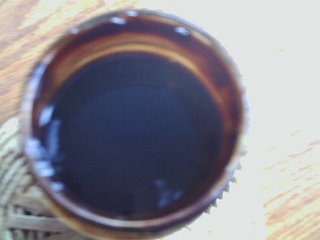 Well, my kvass was interesting. Drinkable? Not really. But interesting. Let's write kvass-making off as a learning experience.
Well, my kvass was interesting. Drinkable? Not really. But interesting. Let's write kvass-making off as a learning experience.I filled two bottles with kvass last Monday morning and left them on a kitchen counter to start fermenting. When I got home I found one of the corks lying in a puddle of kvass next to the bottle. I stuffed the cork back in and let the kvass ferment for a few more days, but not surprisingly the kvass in that bottle was completely flat and tasted terrible. The second bottle, which remained corked the whole time, was closer to the real thing. The kvass was carbonated, smelled right but tasted oddly sour.
I'm not up on my food chemistry, so I'm not sure what happened. Did the recipe call for too little sugar? Was the bread at fault? Someone notes in the comments that you can't make kvass out of borodinsky rye bread, which is what I used.
For the sake of comparison, I made another batch out of kvass starter (photo above), one of the weirder things you can buy at the Russian store. Kvass starter is a thick, molasses-like liquid to which you add sugar, yeast and water. This fake kvass is sugary sweet, but more palatable than the sour batch.
My enthusiasm for making kvass has dimmed a little, although I may try again, using better bread.




5 comments:
Hey Yulinka, sorry I didn't get back to you about the kvass thing sooner! I just dug out a book - Окошки, Квасы, Свеколники - so I'll put down the recipe I used last time.
Bread Kvass -
1.5 kg. rye bread
800 g. sugar
20-30 g. fresh, compressed yeast
30 g. raisins
10 liters water
Cut the bread into sticks, then dry in the oven, lightly browning. Slive into little pieces, set in an container, and pour over with boiling water. Let sit 3-4 hours. The liquid should be a full bucket. When the mix is fully cool, strain the mix to remove the solids - the liquid should be dark brown. Add the sugar, mixing to dissolve, then the yeast. Cover lightly (don't yet seal) and rest for 12 hours. Put in bottles, setting in each 2-3 raisins. Firmly seal the bottles, then set the kvass in a cold place. Tasty kvas is achieved after 4 days.
I did this, scaling down a bit, but used a plastic 2 liter soda bottle, which took the pressure quite well (I admittedly let out a bunch after the first day, and still ended up with a champagne-like kvass. I wouldn't FULLY close the bottle unless you can babysit it, since I'm concerned about it blowing up when I'm not looking. Much as I love kvass, a kvass-bath isn't my idea of a good time.
Good luck, Yulinka! I'll check in after a few days - my wife's about to have our first baby, and we're all excited :-)
And by the way, there are about 50 variants for the recipe listed, so if you're looking for anything specific, just ask!
Tim
Tim--Congrats on the baby!
Thanks for the kvass tips. Where do you find fresh yeast? It's not sold in stores here, so that's why I went with the recipe that called for dry yeast.
Thanks Yulinka, she's a 5.5 lb. munchkin without a name (wife still wants to wait until the form is put in front of her ). I'm calling her Gollum, but she's cuter than that, really. :-P
I've found it's never a really big deal to switch one for the other! I used to find it at my Dominick's near the cream cheese and kosher pickles in the back of the store.
You'll use less dry yeast than fresh, but I don't fuss so much. It's about 1/4-1/2 the weight of the fresh, which has lots of water and dead yeast cells.
I was wondering why your kvass would turn out so sour - if the yeast undergoes anarobic fermentation, you'll make alcohol - then if later they come into contact with air, they might decide, if food is low, to turn the alcohol into acetic acid. It's why my bread dough that's left after a few days in the fridge begins to smell winey (alcohol) and vinagery (acetic acid).
But everything I've found indicates that the primary acid in kvass should be lactic - that's mostly made by strains of lactobacillus and streptococcus in yogurt. Since my kvass was too sweet and not in the least sour, I'm going to try adding a spoon of sour-cream whey to the water after it cools to about 75C.
It seems to me that the primary fermentation in a kvass USED to be the lactic - thus кващеная капуста , and the beet kvass used to make cold borshch - no sugar besides what's already available is added, and no yeast, the mix just sours up like pickles, naturally :-)
Seems to me the yeast, since it produces so little alcohol relative to the amount of sugar available, is mostly valued for the carbonation it provides.
I'm going to be experimenting to produce a better kvass, don't lose heart, there aren't enough people trying to keep this drink alive :-)
Tim,
Thanks for all the tips! I'm still working through the food chemistry part of it.
Let me know how your kvass-making goes. Kvass calls for so few ingredients and seems easy to make, but I guess it's not so different from making homemade bread.
Hey, I am trying to make kvass and came across your post about it. It's interesting to read about others' experiences :)
Post a Comment